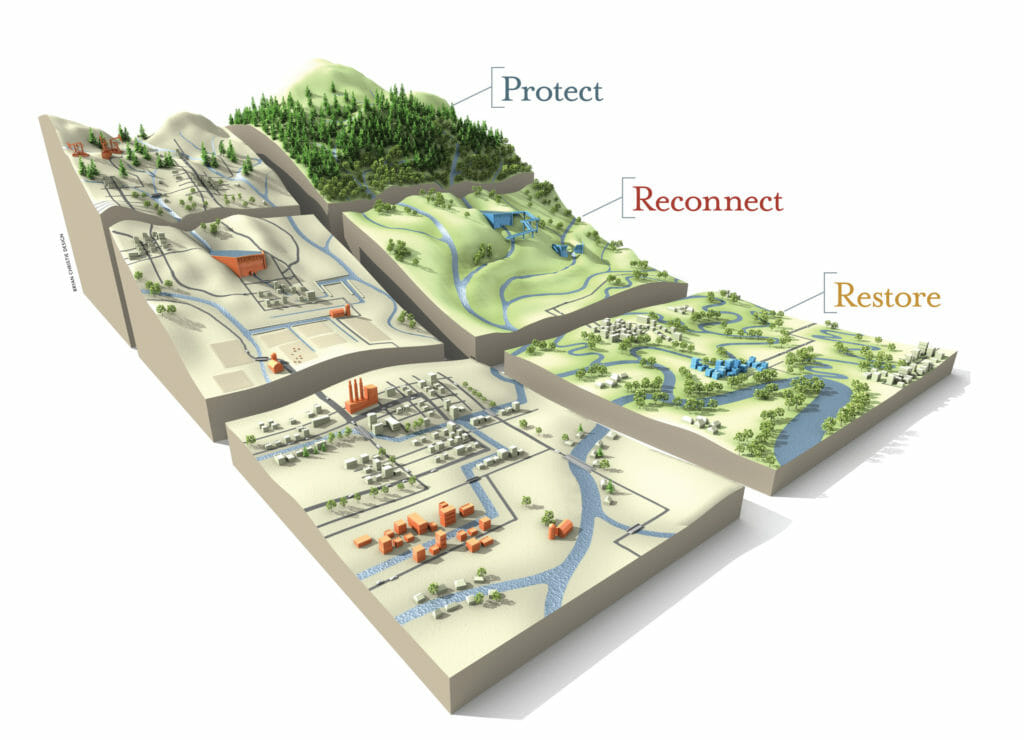The strategic planning process offers volunteer leaders an opportunity to step back and look at the chapter as a whole and develop as a group a concrete description of the impact the chapter intends to make over the next few years. It is a time to connect the dots between mission and programs, to specify the resources that will be required to deliver those programs, and to establish measures that allow everyone to understand whether the desired results are being achieved. This is a critical process to ensure your chapter’s resource allocations (volunteer time and money) are aligned with our mission and intended impact, and a time to seek greater coordination and collaboration between chapters, councils, partners, and staff for enhanced policy influence, fundraising, and conservation impact.
Just as no one TU chapter is the same as another, there is no “one size fits all” approach to strategic planning. The following instructions, resources and template are designed only to support your efforts and assist with cross-organizational coordination and prioritization. Remember, a successful plan is, by definition, a usable plan, so this process should not be onerous. Simply setting some goals and commitments for the next three to five years in coordination with your state council and local staff, where applicable, can make a substantial difference in the effectiveness, directedness, and relevance of your chapter.
A New Direction.
The harder we work, the more we realize how much work remains.
So we’re retooling, recruiting, and reinforcing. With a new strategic direction over the next five years and beyond, we will build on the great work of those who came before us.
We will recruit a larger, younger, and more diverse array of communities and conservation advocates willing to roll up their sleeves.
Strategic Planning Resources
Ready to get started on your local chapter’s plan? These resources can help inspire and organize ideas as you work through your planning process:
Trout Unlimited Strategic Plan
Your chapters strategic plan should follow the mission and goals of Trout Unlimited’s national plan but with a focus on the issues and resources in your local community. You should also check with your state council to see if there is a state strategic plan with specific goals you can incorporate
Chapter Strategic Planning Presentation
This presentation, given at the 2023 Southeast Regional Rendezvous, reviews some of the best practices and tips and tactics for developing a chapter strategic plan.
The Strategic Planning Template
This document can be used as a guide, or just as a starting point to help your chapter organize your strategic planning process.
Using Data to Drive Strategy
This one-hour recorded training reviews how your chapter can use your Annual Financial Report and other data to develop aspects of your plan.
TU’s Mission.
Our mission is to bring together diverse interests to care for and recover rivers and streams so our children can experience the joy of wild and native trout and salmon.
Strategic Planning Instructions
Below, you’ll find some general tips and guidelines for developing your chapter’s strategic plan including and a few examples of how a simple strategic plan can lay the groundwork for your chapter’s efforts.
- Convene a small committee of the chapter board. Thoughtfully populate this committee with a diverse group of people. Not all strategic planning committee members need to be current board members. A chair of the committee should be identified so that it is clear who is responsible for facilitating meetings, identifying action items and following through.
- All chapter strategic planning committee members should become familiar with Trout Unlimited’s strategic plan and your state council’s strategic plan. Your chapter’s strategic plan should follow the mission, vision, and values in TU’s national plan and incorporate any “priority waters” and engagement goals in your local council’s plan (where applicable.)
- All chapter strategic planning committee members should become familiar with TU’s new “priority waters” concept — check out our strategic plan FAQ. To leverage the full power of our TU community of staff, volunteers, partners, and supporters it is critical that every chapter comes together and focuses our conservation and engagement efforts on priority waters. Even if you don’t have an identified priority water in-state, your chapter is encouraged to look regionally to identify places you might impact with your advocacy, funding, or other means. Chapters also play a key role in engaging whole communities in the stewardship of their backyard rivers and streams, so it is entirely appropriate to incorporate additional issues and resources in your local community and chapter’s geographic range beyond state-level identified “priority waters.” (A sample evaluation matrix for prioritizing these additional local opportunities is provided below.)
- This strategic planning workgroup should start by collecting feedback from your members, partners, and regionally based staff about the chapter’s internal strengths and weaknesses, and also your external opportunities and threats, a process commonly called a “SWOT” analysis. This is your time to take stock of what is working well, what could work better, and what is missing. Without a clear understanding of the current state of affairs, it’s hard to think critically about what you are best positioned to do going forward or what changes you may need to make. Gathering outside perspective can be incredibly helpful. Surveys are a good tool for gathering this information, but so too are simple conversations. As you go through, it’s not enough to ask, “What is our chapter’s biggest weakness?” you have to go a step further and say, “Why have we neglected this area?” It also helps to think of your strengths as opportunities for growth. “We have great engagement on social media, but how can we move a higher percentage of those supporters to volunteer?” When your committee meets to discuss the results of the SWOT analysis or similar process, make sure you ask yourself the question, “How well does each of our current programs or activities align with our mission and intended impact?”
- In a subsequent meeting, it’s time to put pen to paper and draft the elements of the plan. The template below is designed to support this initial outline draft. Each chapter is encouraged to think about three categories of goals to include within your plan: 1) connection to state or regional priority waters and/or local opportunity waters; 2) the engagement of whole communities; and 3) resourcing your work. When formulating objectives be as specific as possible about what your chapter hopes to achieve. If the outcomes are measurable in terms of miles of habitat restored, numbers of fish populations impacted, people influenced, etc… include those targets. When formulating strategies consider what needs to be influenced or changed, who can make those decisions, who are the other important audiences, what are the best ways to reach those audiences, which partners need to be engaged and what resources need to be garnered.
- The chair of the strategic planning committee then takes the outline draft written by committee and cleans it up into a short, clean and compelling piece. This draft plan is then passed by the full chapter board of directors and the chapter’s council for review and input. After that, the plan is finalized and should be uploaded to the Leaders Only Tools section of tu.org so that all chapter board members can easily access and review it over the life of the plan. Strategic plans can also make compelling pieces for fundraising and board recruitment. Accordingly, consider publishing your chapter’s plan in a public-facing manner.
- The strategic planning committee should set calendar reminders to bring the plan forward bi-annually (or more frequently) at a board meeting to ensure the chapter is on track or even to edit or revise it as things change.

– Chris Wood, President & CEO


